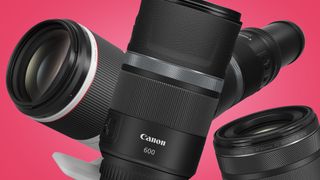
Today's huge Canon event wasn't just about the launch of the Canon EOS R5 and Canon EOS R6 – we also saw the arrival of four new RF lenses, which are all pretty exciting for very different reasons.
Perhaps the most heartening theme, particularly in these tricky economic times, was a move towards (relative) affordability for Canon's new lens family.
If you own a camera like the Canon EOS RP, or have been eyeing up a second-hand Canon EOS R, then you'll have been pleased to see the arrival of the Canon RF 85mm f/2 IS STM Macro.
The most intriguing additions, though, are the two new RF ultra-telephotos: the Canon RF 600mm f/11 IS STM and RF 800mm f/11 IS STM. These are theoretically ideal for safari-goers, and also come with relatively tempting price tags.
Towards the other end of the scale is a new super-tele zoom called the Canon RF 100-500mm f/4.5-7.1L IS USM, which is very much designed for pro sports and wildlife snappers.
Luckily, we had a chance to get hands-on with all of Canon's new lenses, plus its two new RF extenders, during our preview of the Canon EOS R5 and EOS R6. Here are our early thoughts on how they're shaping up...
- Read our hands-on Canon EOS R5 review
- Canon EOS R5 vs EOS R6: 10 key differences you need to know
- Or check out our hands-on Canon EOS R6 review
Canon RF 600mm f/11 IS STM and RF 800mm f/11 IS STM
- Canon RF 600mm f/11 IS STM pricing: $699 / £750 (around AU$1,360)
- Canon RF 800mm f/11 IS STM pricing: $899 / £980 (around AU$1,775)
How much reach do you want? For plenty of photographers – wildlife snappers for and sports shooters, for example – the answer is “all I can get.” The traditional drawback: very long lenses are exceptionally heavy and, particularly at the pro end of the market, stupendously expensive.
Get daily insight, inspiration and deals in your inbox
Get the hottest deals available in your inbox plus news, reviews, opinion, analysis and more from the TechRadar team.
Enter Canon, with a pair of fascinating ultra-telephotos that will lure wildlife photographers like badgers to a jam sandwich. Compared to traditional long lenses, the 800mm and 600mm are a pair of ultra-portable, ultra-telephotos which, while unlikely to unseat the giant white lenses dotted around the edges of pro sports fields, are nonetheless likely to find happy homes in the camera bags of avid safari-goers everywhere.
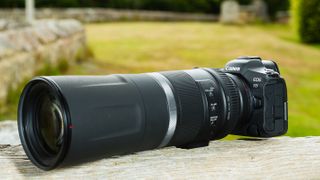
Both lenses are a doddle to use – they telescope out once you’ve twisted the rotating locking ring, which then twists back to fix the lens in its extended position. Compared to professional prime telephotos they’re pretty light too – 930g for the 600mm and 1.26kg for the 800mm is barely-there. They both use STM (Stepper Motor) focussing, which is quieter than traditional autofocus mechanisms and thus preferable for those shooting long-range video.
The drawbacks? The obvious one is in the title – f/11 is a very small aperture by any standard. For example, if you’re shooting a subject at 1/500th of a second at ISO 800 and f/4, closing the aperture down to f/11 means changing the shutter speed to 1/125th, or increasing the ISO to ISO 3200, increasing your chances of a motion-blurred shot or a noisy shot respectively. In theory, at least.
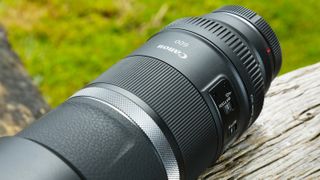
With the EOS R range excelling at high ISOs and autofocus, it’s clear Canon is simply relying on ever-improving image quality at high ISOs to offset the smaller aperture. Still, with many photographers absolutely phobic about even the slightest hint of noise in their images, it’s possible such a small maximum aperture could be unpalatable for many.
On the plus side, there’s plenty of image stabilization built in – up to five stops on the 600mm and up to four stops on the 800mm. These are lenses we're very keen to see use in the real world – and reluctant to judge either way until we have.
Canon RF 100-500mm f/4.5-7.1L IS USM
- Canon RF 100-500mm f/4.5-7.1L IS USM pricing: $2,699 / £2,900 (around AU$5,250)
Canon has made some legendary prosumer lenses. Of these, the fantastic Canon EF 100-400mm f/4.5-5.6L IS II USM is surely among the very best, as is its venerable Mark I predecessor. Its build quality is superb, and image quality is fantastic.
Canon has to be hoping the RF 100-500mm f/4.5-7.1L IS USM will join its ranks. The 500mm end is an eminently sensible focal length for even fairly ambitious safaris. But as with the diffractive prime lenses above, it was previously unobtainable without spending either gigantic sums to stay within the cosy Canon ecosystem or opting for third-party glass.
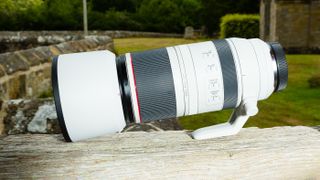
Landing at a very appealing price, the 100-500mm offers photographers the reach of an ultra-telephoto in an outlandishly convenient body. Zoomed in and packed up, it weighs about the same as the existing 100-400mm, which is itself comparable to the 70-200mm f/2.8L IS. Impressively, this is about 13% lighter than the 100-400mm and just ever so slightly longer, despite offering 100mm more focal reach.
Handling wise, it’s pretty convenient – most won’t require a tripod when they’re using it thanks to its 1.37kg weight, and the ability to start the lens zoomed-out before zooming in to compose alleviates the steep learning curve associated with long telephoto primes. Those who can afford it will love it.

Again, the small aperture once you’re zoomed in catches the attention. Of course, f/7.1 isn't quite as constraining as the f/11 of the diffractive primes above, but it’s nonetheless pretty dark and will force photographers into either higher ISOs or longer shutter speeds. Again, Canon and its fans will be banking on excellent high-ISO performance from its RF-mount cameras to offset the darker aperture, as well as good image stabilisation performance.
Canon RF 85mm f/2 Macro IS STM
- Canon RF 85mm f/2 Macro IS STM price: $599 / £650 (around AU$1,180)
The Canon 'Reimagine' launch wasn't just about new cameras and eye-catching zooms – lenses like this RF 85mm F2 Macro are an essential part of giving the RF-mount widespread appeal.
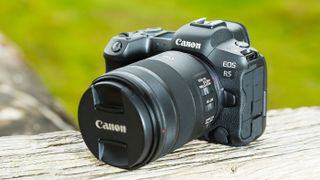
There are plenty of desirable L-series prime lenses for RF cameras – not least the RF 85mm F1.2L USM – but more affordable primes will keep RF cameras appealing for those with more earth-bound budgets.
At this price, you can expect to see plenty of macro photographers adding this to their Christmas lists. Apart from its fast maximum aperture and image stabilization, it has a close-focussing distance as near as 35mm to the camera’s focal plane, giving it an excellent magnification ratio of 1:2. This means objects are half the size on the sensor as they are in real life.
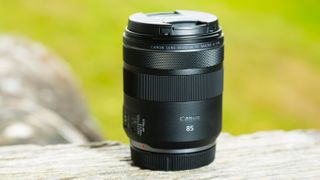
It’s also a lens with a perfect focal length and aperture for portraiture. By the standards of the eye-catching optics elsewhere in Canon’s July extravaganza, it’s pretty ordinary. But it's likely to find a lot of fans.
Canon Extender RF 1.4x & Extender RF 2x
- Canon Extender RF 1.4x pricing: $499 / £559 (around AU$1,010
- Canon Extender RF 2x pricing: $599 / £699 (around AU$1,265)
These extenders will be also-rans for many, but in truth these are critical components of the RF-mount ecosystem.
Up until now if you wanted to use an extender on an RF-mount camera you’d have to use an EF or EF-S mount lens, then an extender, then one of Canon’s mount adapters.


With these, you can now use extenders on Canon’s various RF-mount lenses. Fancy converting the 100-500mm to a 420-700mm ultra-ultra telephoto? No problem, although the extender doesn’t work unless the 100-500mm is zoomed to at least 300mm.

On the downside, they're not compatible with all RF lenses – only the Canon RF 100-500mm f/4.5-7.1L IS USM, RF 600mm f/11 IS and RF 800mm f/11 IS STM.
Still, it might be worth regarding the new extenders as investments rather than pieces of kit you’ll be able to use extensively straightaway.
- These are the best Canon lenses you can buy right now
The TechRadar hive mind. The Megazord. The Voltron. When our powers combine, we become 'TECHRADAR STAFF'. You'll usually see this author name when the entire team has collaborated on a project or an article, whether that's a run-down ranking of our favorite Marvel films, or a round-up of all the coolest things we've collectively seen at annual tech shows like CES and MWC. We are one.
Most Popular

